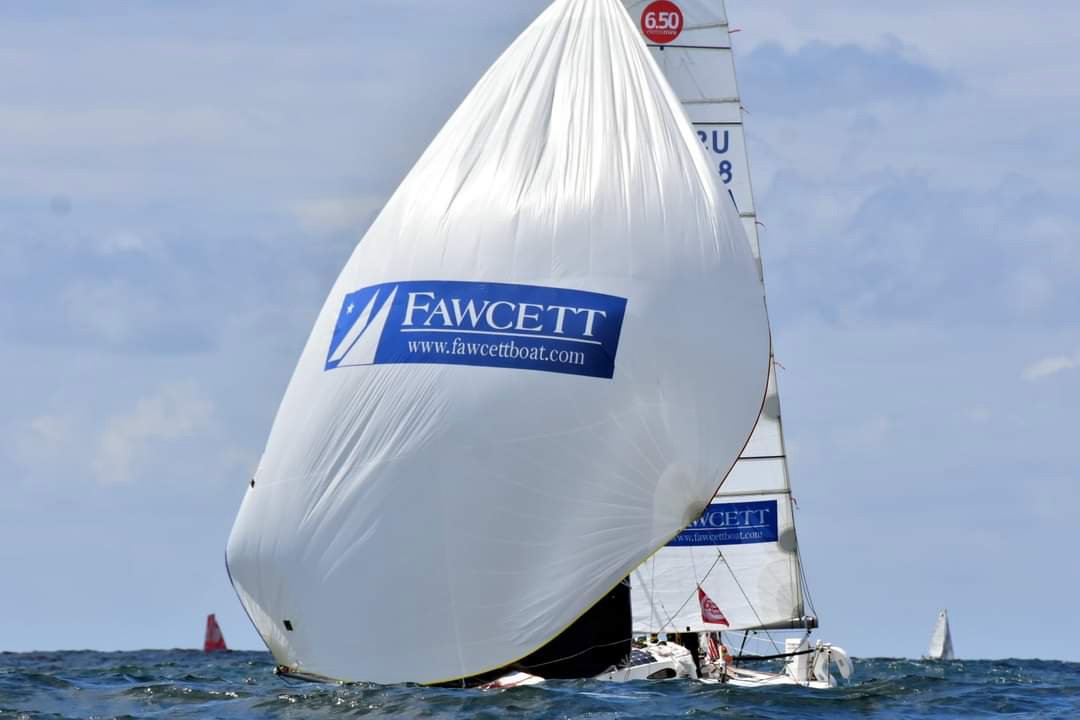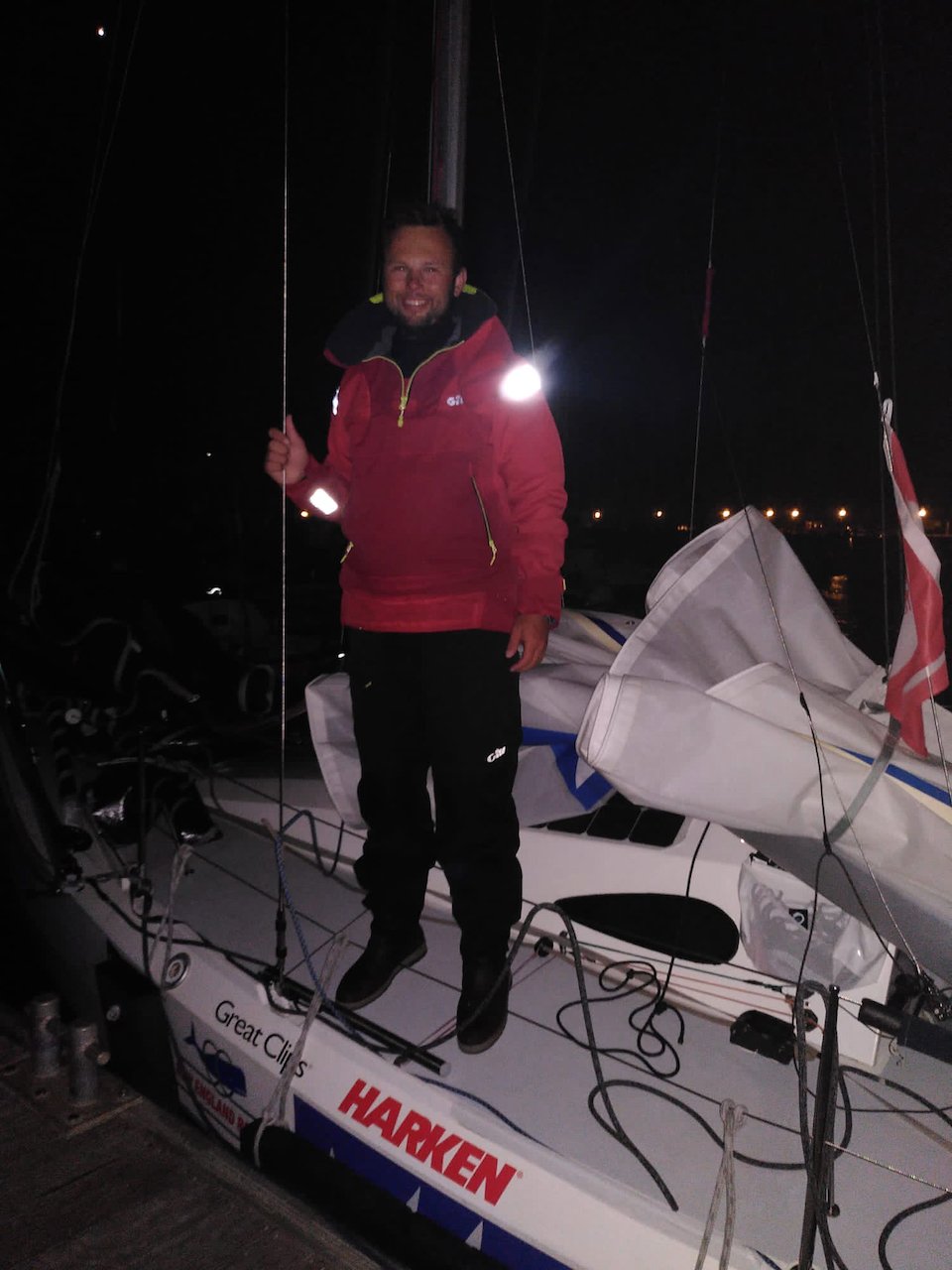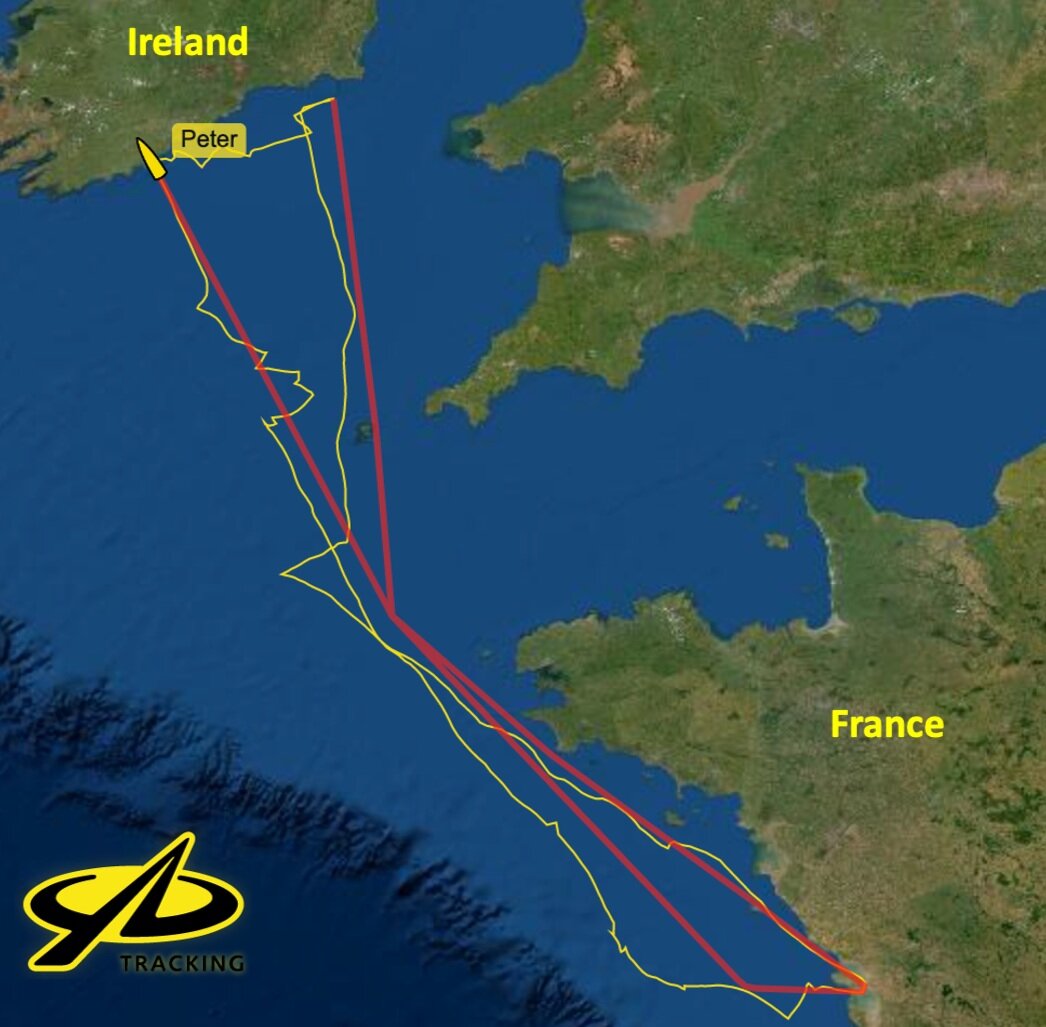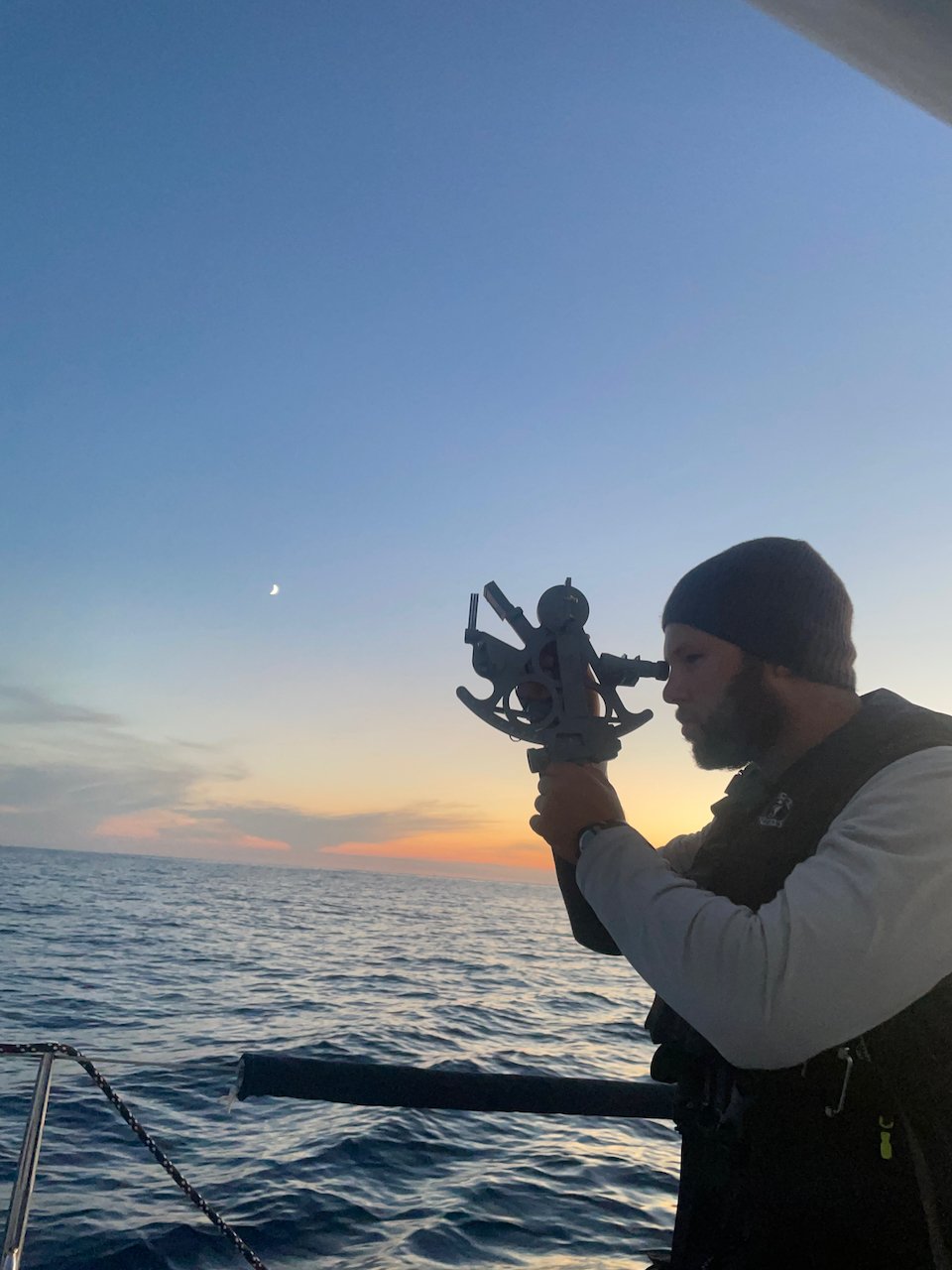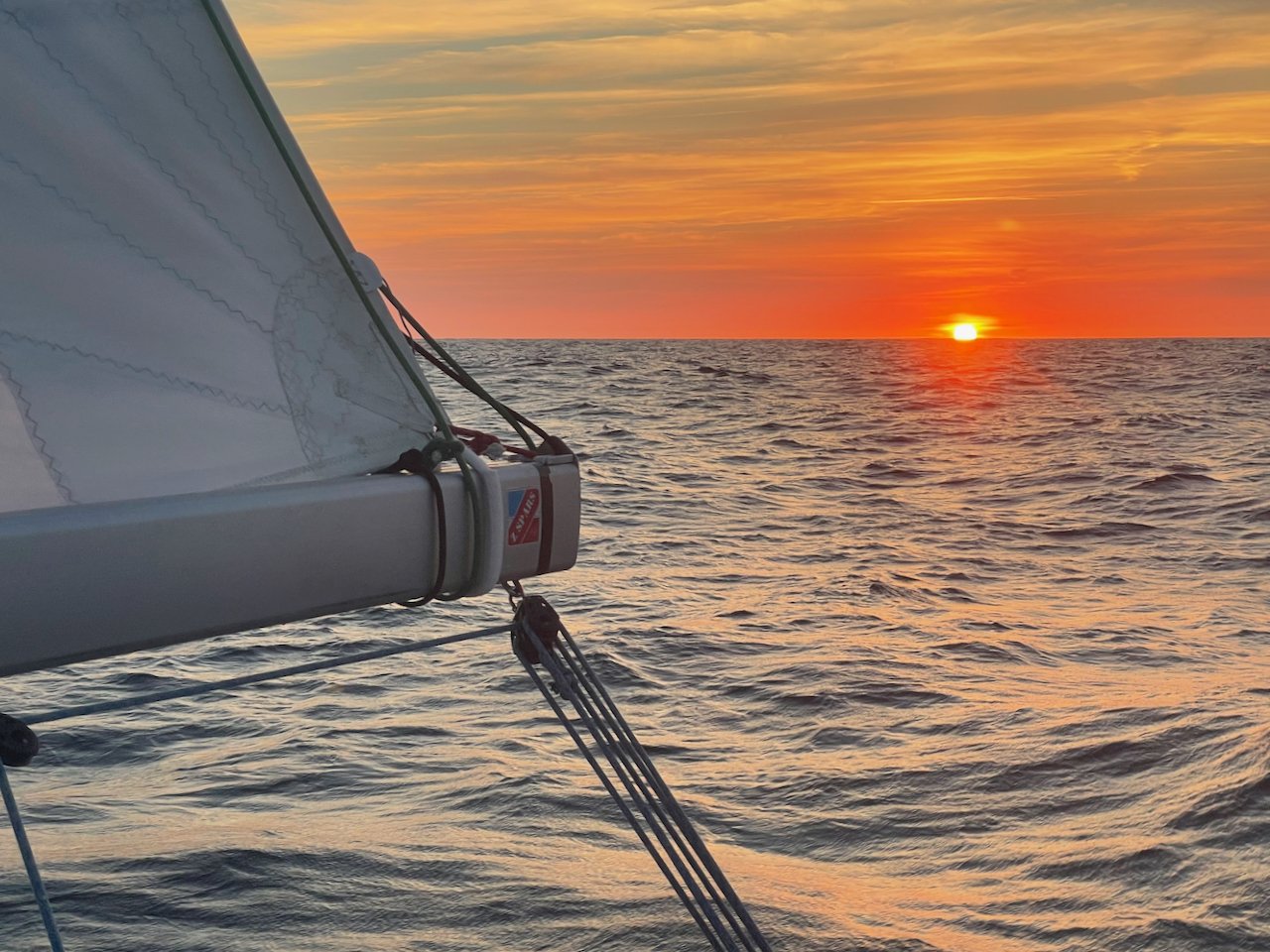3,400 Nautical Miles
One Mini season complete in preparation for the 2023 Mini Transat
In 2007 I entered the U.S. Naval Academy and served on active duty in the Marine Corps until this past year. After fourteen years of this regimented lifestyle, I had the opportunity to hang up the uniform and pursue a new adventure. I decided to sail alone in a 21-foot sailboat off the coast of France, with a mission to qualify for the Mini Transat. The Mini Transat is a 4,000+ nautical mile (nm) solo race across the Atlantic Ocean. This journey is about reconnecting with the ocean and raising awareness for a military veteran group that I am deeply passionate in supporting.
With over 3,400 nm sailed on Terminal Leave this season, let’s recap the highlights from this year.
Miles Raced: 936 nm
Solo Miles: 2,225 nm
Total Miles Sailed: 3,406 nm
This Mini Transat campaign aims to raise awareness for U.S. Patriot Sailing by competing in this ultimate challenge, racing solo across the Atlantic Ocean on such a small boat. The requirements to qualify are extremely demanding, in addition to the physical and mental tests faced during race. Despite the difficulties faced this past year and having to shift my mission to the 2023 Mini Transat, I still believe I am on the right path to achieving my original goal.
After significant delays in getting permission to enter France due to COVID restrictions on Americans, seemingly endless boat preparations, and taking a World Sailing sea survival course in French, I was finally able to set off in the ocean.
I was eager to get out on the race course and earn my spot for the Mini Transat, even though I had missed the first two races of my season.
Delivery from La Trinité-sur-Mer to Douanenez
On the morning of 23 June I departed my home base at La Trinité-sur-Mer, FR for a double-handed delivery of 110 nm northwest to the port town of Douarnenez. Madison, my co-skipper for this delivery and first race, is an American living in France who also was starting her own Mini campaign. This transit also counted as my 24-hour training sail required to compete in a “C level” event. C level races are overnight events, but each leg is under 300 nm long. The Classe Mini organization then requires skippers to submit a personal assessment to ensure the boat and sailor are ready for this type of competition.
This delivery would be my first time sailing Terminal Leave offshore and at night. I had the usual feelings associated with finishing last-minute projects, just wishing I had a few more hours to prepare. The effort that went into getting the boat ready in Annapolis, shipped across the ocean, and put back together had me not wanting to take any significant risks my first night out. Any major breakages could end the season before the first race even began. As planned, we left the dock that morning into a beautiful Quiberon Bay, passed through a narrow channel, and set a northwesterly course into the Bay of Biscay.
The day and most of the evening were relatively uneventful; perfect upwind sailing to test the boat and her systems. We had even timed the Raz de Sein tide as well as we could have from that far out. The Raz de Sein is a narrow stretch of water (1.5 nm wide) between a point off the French mainland and a small island with rocks angled east to west about 12 nm long. This region is notorious for strong tidal currents over 6 knots which can be very dangerous.
First time sailing offshore on Terminal Leave on 23 June
That night it was very dark with about 20 knots of wind and a strong flood tide bringing us into Douarnenez Bay. Sailing through the Raz de Sein at about 0300 was going to consist of a tack followed by falling off the wind at the appropriate time. However, during this maneuver, we both got disoriented and confused at the multiple sets of lights we could see (indicating rocks in all directions). Surfing down waves, with the wind shifting, we just couldn’t hold the course we wanted and had to jibe. This was my first serious gibe with the new mast in breeze, therefore cautious about the rig surviving. We both were not comfortable with the navigation, so I turned over the tiller and took a look at the charts. If we were going on the rocks, it would be because of my navigation error, not my co-skipper’s fault.
We were both seriously disoriented by now (class rules dictate no chart plotter onboard), and at a time almost not believing the GPS location, I took a moment to reset. I took a fresh look at the chart and our location and realized we had pulled a 180 degree turn into a strong current with steep waves, and were now heading towards steep cliffs of the Pointe du Raz!
We quickly established a new beam reach course on port tack into the Douarnenez Bay. Within about 10 minutes, we passed beyond the extremely turbulent waters of the Raz, and all was peaceful again. It quickly turned into a beautiful early morning with a softening breeze.
Quietly motoring into the Port de Plaisance in Douarnenez on that overcast morning was picturesque. I had survived my first night out at sea on Terminal Leave and was ready to start the race check-in process with a detailed safety inspection.
However, it was also not lost on me just how close we were to a perilous situation. Fortunately, my co-skipper had recently helped deliver a Mini through the Raz de Sein and knew the waters much better than I. Without her local knowledge about timing the current, the delivery could have gone much differently. At the same time, this served as a reminder of the sheer power of the waters off France. This area was new to me and made me hungry to learn more about the region while respecting the natural elements.
Mini Calvados Cup
After having every square inch of the boat inspected, in pouring rain, we were ready to race. The Mini Calvados Cup Race 1 was 256 nm of intense double-handed racing up to Normandy. After leaving the Douarnenez Bay in very light upwind conditions, we headed north between the mainland and more islands. This consisted of some boats anchoring due to the light wind and strong currents. I was too stubborn to stop and kept sailing in circles around anchored competitors, often repeatedly passing the same boat. While some sailors enjoyed the few hours at anchor, others bumped their keels against rocks, which is always a concern when anchoring in these waters. Therefore I still think I made the correct call at the time.
This race turned into a drifter; some boats anchored multiple times throughout the course. After 3 days and 9 hours at sea, with an average boat speed of just 3.14 kts, we made it to the entrance of Deauville right at sunset. After waiting 4 hours for the tide to rise, we finally got a tow through the lock and into the port. The change in tide is so great here in the Normandy region that many ports keep the water for marinas at a certain range of depths through the use of a lock to prevent a very low tide.
Arriving into Deauville Yacht Club at the end of the first race
The start of the Mini Calvados Cup Race 2 was scheduled to cross the English Channel and return to Deauville. However, due to the delay in arrival for all boats from the first race and a very light wind forecast, the race committee smartly shortened the course to a 115 nm overnight race just off the Normandy coast. My co-skipper for this race was a Normandy local from La Havre named Antoine. He had previously owned a Mini, knew the area, and could translate the radio calls which really helped. Even though we didn’t speak much of each other’s language, it’s amazing how you can easily find ways to communicate while racing offshore.
On the morning of 2 July we were off once again! There was a strong breeze for the start with a one mile upwind beat, then a 30 nm reach with the code 0. Sailing just on the borderline of needing to put in the first reef, these conditions were exciting, with the Minis popping up out of the water and taking off with double digit speeds.
However, shortly after sunset, the wind dropped to below 5 knots, and once again, we were slowly drifting. Luckily the wind picked up at sunrise, but it was a slow night. The final mark was close to the shore of Cabourg. This was the area of Sword Beach on D-Day in WWII, the farthest east landing and assigned to the British military. Words cannot do justice to what it was like sailing in these historic waters where so many made the ultimate sacrifice.
This race was a sprint and felt more like an extended day race around the buoys. Most of the racing was split evenly, either directly upwind or downwind, which required many sail changes quickly to remain competitive with the fleet. After 25 hours and 9 minutes, we finally crossed the finish line with an average boat speed of only 4.5 knots. A few of the boats couldn’t even make the finish line before the time limit expired due to the wind giving out at the end. Did I mention these boats do not like going upwind in light air?!
Co-Skipper Antoine and I after the overnight race
After racing, the next few days were spent at the dock waiting for a nasty low-pressure system to pass through the English Channel. The Deauville Yacht Club and its volunteers did an excellent job welcoming us and taking care of my fellow Mini sailors. For the small group that remained through the storm, the volunteers hosted a local seafood dinner and even gave us a private tour of the local horse race track in Deauville. A volunteer who helped tow us in at one in the morning is also one of the leading horse trainers at the track. This little Normandy yacht club is by far one of the most hospitable groups of people I met while in France.
Delivery from Deauville to La Trinité-sur-Mer
On 7 July it was time to depart Deauville and sail back to La Trinité-sur-Mer. This 360 nm sail would be my first time solo sailing, no better place to start than the unforgiving English Channel. I experienced a wide variety of conditions during this transit, and it served as an excellent training mission. Learning through sail changes, reefing, navigation, and sleep management really taught me a lot that I could use going forward.
I wasn’t sure exactly what to expect for my first solo sail, but I ended up really enjoying the experience. It took 4 days and 18 hours, but I finally made it back to La Trinité-sur-Mer. Sailing mostly upwind, combined with going backward for half a day due to no wind and strong currents, really slowed down the delivery. However, experiencing symptoms of sleep deprivation, the solar panels not charging due to little sunlight, avoiding the many ships in the English Channel, and overcoming new challenges each day made this delivery a massive success.
Puru Challenge Race
On 22 July it was time to head back out into the Bay of Biscay. I departed that evening for a 90 nm solo delivery south from La Trinité-sur-Mer to Port Bourgenay. This overnight, upwind passage was a great test of my new Quantum Sails that had just arrived. We always have to report a few days in advance of each race to complete the necessary check-in process and safety inspections by the race organization.
The navigation lights are tested before the start of each race
The Puru Challenge Race, also known as the Mini Gascogna, is a two-stage competition with the option to race solo or double-handed, in either the series or prototype class. I chose the solo race on my series boat, the largest class of 47 skippers. On 28 July, we departed for the 375 nm sail to Getxo, Spain. All 70 Minis lined up and crossed the start at the same time.
Instead of heading south towards Spain right after the start, the race course first went to the west, then northwest past La Trinité-sur-Mer, around Belle île, and then 250 nm south for the final leg to Spain.
Light wind with choppy seas made it difficult to keep the spinnaker full
This race was tough but it felt incredible to finish my first solo race on Terminal Leave. Throughout 2 days and 20 hours of racing, I experienced wind conditions ranging from drifting again to my first big squall in the Bay of Biscay of over 30+ knots with heavy rain at night. Not only was I focused on keeping the boat in one piece during the squall, but I also had to avoid about a dozen fellow Minis, as we were drag racing on the same tack in reduced visibility.
Before you know it, you quickly lose sight of your competitors as the weather moves in…then all you can really see are the masthead lights bobbing in the water. The large waves swallow up the Minis and block your view from seeing the rest of the boats. We were all on slightly different headings depending on our individual strategy, so it felt like boats were suddenly appearing out of nowhere. No one got much sleep that night.
After a few days of rest and repairs, the second stage started on the afternoon of 3 August from Getxo, Spain back to Port Bourgenay, France. Due to an initial period of light winds, followed by a deep low-pressure system moving in, the race organizers decided to shorten the course to 190 nm.
The race started out light and upwind, just enough to begin the race. However, shortly afterwards the wind shut off and we drifted. For at least six hours, I could still see the area where the starting line was set up and the entrance to Getxo. It was probably one of the most painful light air sailing experiences since it occurred right after the start.
The wind finally filled in that evening and I had some of my best downwind sailing conditions. With a steady 20-22 knots of wind, I flew the big A2 spinnaker, kept the pole winched up slightly to weather, and tried to make up for lost time. All was under control until the wind started gusting above 23 knots and it was just too much for the boat. Terminal Leave broached hard in the pitch-black night, and it was time to reduce sail.
The Bay of Biscay certainly lived up to its reputation during this stage. I ended up sailing in a steady 30-32 knots of wind for most of the day, with gusts over 37+ knots. Even with a double-reefed main and a reefed jib, the boat speed surpassed 13 knots.
There were also big seas driven in by the low-pressure system. As the waves move across the Atlantic Ocean, they gain serious energy. The big swells with all this stored energy quickly turn into steep waves as the bathymetry changes and the depth becomes shallow along the French coast.
One of these waves hit Terminal Leave on her beam and launched the boat onto her side. At the time, I was standing up in the cockpit looking at the horizon. In an instant I was then looking at a vertical deck….meaning the boat was perpendicular to its usual angle. The mast was likely touching the water or just above the wave’s trough. After 1 day and 12 hours, I successfully (and in one piece) finished the race in the middle of the night at the entrance of Port Bourgenay.
Completing my first solo distance race was a big accomplishment; however, it came with a mix of emotions. This marked the final race of the 2021 season for me since I could not qualify for this year’s Mini Transat race. I felt proud of how much we accomplished this past year (there were many people who helped me get that far) but I also felt like I had let down so many friends and family who were supporting me. I was not necessarily pleased with my finishes in the races, but I know there are many more days of training and racing ahead to prepare even better for the next Mini Transat in 2023.
Finishing the second stage of the Puru Challenge Race
Shortly after the race, I sailed the boat back north 90 nm to La Trintié-sur-Mer. At this point, I had sailed the boat 1,586 nm and it was time to shift focus to one final milestone in the season. Before I packed up the boat for the season, I was determined to complete my 1,000 nm solo qualification sail required for the level A races. However… since my visa was not approved, I could not stay in France for more than 90 days. The solution? Sail to Ireland and relocate for a few weeks. Yes, they are both in the EU, however, Ireland is not part of the Schengen Zone so the clock stopped once I got stamped out of France.
Delivery from La Trinité-sur-Mer to Kinsale, Ireland
After talking to a Mini sailor from Ireland, I decided to sail to Kinsale, Ireland. The delivery was 350 nm from La Trinité-sur-Mer, which after all the sailing I had just completed, did not sound too far anymore. My girlfriend and lead shore support manager Jane Millman flew over and helped with the delivery. This was the first time actually crossing the English Channel and the Celtic Sea, so I was grateful to have an extra hand on board.
On the afternoon of 21 August we arrived in the beautiful little port town of Kinsale in just under 3 days. Coincidentally, as we were coming into the channel, fellow Annapolis sailor Andy Schell from 59° North Sailing was departing with his Swan 59 ICEBEAR. Andy actually helped answer some questions for me about the area and clearing customs ahead of time. Check out his “On the Wind” podcast; he interviews some really interesting sailors.
While in Ireland, we balanced the time between cleaning up the boat from the delivery, doing a few projects in preparation for the qualification, and a little sightseeing. We rented a camper van which gave us the flexibility to live near the boat at the marina part of the time and drive across the country at our own pace. Driving the Wild Atlantic Way with its breathtaking views was unforgettable. This was actually my first time all season stepping away from the boat for a few days, I believe this helped me reset mentally and relax before the upcoming challenge.
Cliffs of Moher, west coast of Ireland
Terminal Leave docked at Castlepark Marina in Kinsale
Solo Qualification Sail
To qualify for the Mini Transat, each skipper must complete a 1,000 nm solo qualification sail on either the Atlantic or Mediterranean course. The skipper must then provide charts, a detailed logbook, and celestial navigation calculations demonstrating proficiency to a board that approves the qualification.
I choose the Atlantic course, which consists of three marks with two along the French coast and one near the southeastern coast of Ireland. You can start and finish anywhere you choose, as long as you round all three marks and sail over a thousand miles. This facilitates skippers from all along the French coast to complete the course from any port. This is also why Kinsale was a great location to start from because it was only about 70 nm away from one of the marks.
On 7 September I departed Kinsale and set a southeasterly course towards France. The first mark was about 415 nm away at the Plateau de Rochebonne. To get there I had to cross the Celtic Sea, traverse the entrance of the English Channel, round the channel’s main Traffic Separation Scheme (TSS) off the French coast, and negotiate the northern half of the Bay of Biscay.
Sailing east for 50 nm, I then rounded Ile de Ré just off the coast of La Rochelle on day 6. The next leg was the longest at over 450 nm and headed back northwest towards Ireland. Once again, sailing through the northern half of the Bay of Biscay, rounding the TSS off the Ile d’Ouessant, crossing the English Channel, keeping clear of the UK’s Isles of Scilly TSS, then turning north and crossing the Celtic Sea towards Irelands southeasterly coastline.
I finally approached the Irish coastline after a fantastic downwind sail with the spinnaker up in 15-20+ knots for most of day 10 across the Celtic sea. At 2110 that evening, I rounded the third and final mark of the course at the Coningbeg Buoy with a log of 1,016 nm. Now just a 70 nm sail to the southwest back to Kinsale…or so I thought!
That final night I experienced the most severe weather of the entire season. I was seriously concerned about breaking the boat and the rig due to the large, steep waves hitting the boat from multiple directions. Check out my September SITREP blog post HERE for the full story.
On 17 September at 1910 I pulled back into Kinsale Harbor and completed 1,120.75 nm in 10 days 2 hr 25 min. That final night was a serious test of the boat and me through strong wind, tall seas, and endless rain. What a way to end the qualifier; a night at sea I will certainly never forget.
What is the equivalent to sailing 1,120 nm in North America? On the east coast, that is like sailing from Jacksonville, FL to Nova Scotia, Canada. On the west coast, that is the distance by sea from San Diego, CA to Vancouver Island. That is a lot of miles on a small boat!
This solo qualification sail reinforced why it is such a crucial requirement by the Classe Mini organization. While some may call mini skippers crazy for sailing such a small boat solo across the ocean, there are significant preparations with incremental tests along the way. This was one of my tests, and I was guided by my previous experiences sailing. Between the southern Bay of Biscay from Spain and the very technical Mini Calvados Cup races, navigating the many challenges in the northern part of the Bay and the English Channel, I felt more prepared.
Delivery from Kinsale, Ireland to La Trinité-sur-Mer
The final sail of the season was 350 nm back to La Trinité-sur-Mer. Jane once again flew back to help with the delivery and packing up the boat for the winter. After crossing the Celtic Sea and the mouth of the English Channel for the fourth time in a row this season, it was really starting to feel like home. Even with the frequent rain and squalls, I really enjoyed my time in the Celtic Sea with the thrill of some serious sailing but without the ship congestion of the English Channel.
As quickly as the season had started, it was time to put Terminal Leave away for the winter. 3,406 nm sailed this season with vastly different experiences along the way.
Many objectives were accomplished this season between shipping the boat to Europe, transitioning off active duty into the reserves, and successfully completing my first season of solo Mini racing. However, it remains my mission to complete the Mini Transat and I will do everything I can to cross that starting line in 2023 to continue to raise awareness for U.S. Patriot Sailing.
This winter and early spring will be spent in the Annapolis area preparing for next season. Now that I am in the Marine Corps Reserves I have to occasionally “drill” which consists of going into the Pentagon for a little over a month to complete my required time. Fortunately, I remain supporting the same unit I was assigned to during my final two years on active duty. I am also working to complete my masters in Strategic Intelligence at the National Intelligence University with a goal to graduate this spring.
Thank you to everyone who has supported this campaign; I could not have made it this far without the backing of so many friends and family.
Thank you to my sponsors and Supporters for making this all possible: Fawcett Boat Supplies, Switlik Survival Products, Gill Marine, New England Ropes, Yankee Marine, Harken, Great Clips, AYC Foundation








